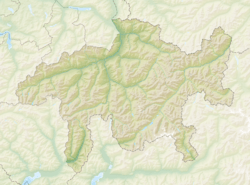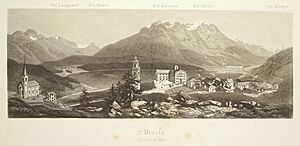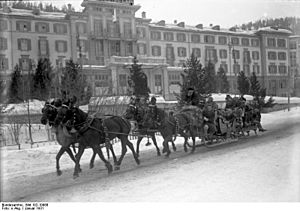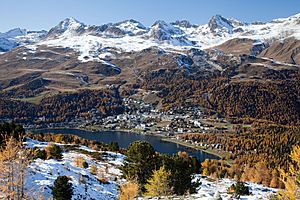St. Moritz facts for kids
Quick facts for kids
St. Moritz
|
||
|---|---|---|
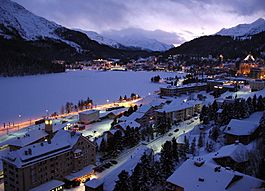
St. Moritz on an evening in February 2009, with the lake frozen
|
||
|
||
| Country | Switzerland | |
| Canton | Grisons | |
| District | Maloja | |
| Area | ||
| • Total | 28.69 km2 (11.08 sq mi) | |
| Elevation
(Traunter Plazzas)
|
1,822 m (5,978 ft) | |
| Population
(Dec 2020 )
|
||
| • Total | 4,945 | |
| • Density | 172.36/km2 (446.41/sq mi) | |
| Demonym(s) | German: St. Moritzer(in) | |
| Postal code |
7500
|
|
| Localities | St. Moritz-Dorf, St. Moritz-Bad, Suvretta, Champfèr (eastern part) | |
| Surrounded by | Bever, Celerina/Schlarigna, Samedan, Silvaplana | |
St. Moritz is a famous Alpine resort town in Switzerland. It is located in the Engadine valley, high up at about 1,800 meters (5,900 feet) above sea level. St. Moritz is the main town in the Upper Engadine area. It is part of the canton of the Grisons in Switzerland.
The town sits on the southern slopes of the Albula Alps. It is below Piz Nair, a mountain that is 3,056 meters (10,026 feet) tall. St. Moritz overlooks the wide valley of the Upper Engadine and its beautiful lake, Lake St. Moritz. This town is very special because it hosted the Winter Olympics twice, in 1928 and 1948.
Contents
A Look Back in Time
People have known about the springs in St. Moritz for a very long time. Objects like offerings, swords, and needles from the Bronze Age (a time thousands of years ago) have been found there. This shows that the Celts already used these springs.
The town's name, St. Moritz, comes from Saint Maurice. He was an early Christian saint from Egypt. He was said to have been killed in the 3rd century in Switzerland. People used to travel to the church of the springs to drink the water. They hoped the blessed water would heal them. In 1519, Pope Leo X even promised special forgiveness to anyone who made a pilgrimage there.
St. Moritz was popular in summer, but it became a winter resort thanks to a bet! In 1864, a hotel owner named Caspar Badrutt made a deal with four British guests. He challenged them to return in winter. If they didn't like it, he would pay for their trip. If they did, they could stay as his guests for free. They loved it! This bet started winter tourism in St. Moritz and across the Alps.
Many "firsts" happened in St. Moritz:
- In 1878, the first electric light in Switzerland was installed at the Kulm Hotel.
- The first curling tournament in Europe was held in 1880.
- The first European Ice-Skating Championships took place in 1882.
- The first golf tournament in the Alps was held in 1889.
- The first bob run and bob race happened in 1890.
- By 1896, St. Moritz had the first electric trams in the Alps.
- A horse race on snow was held in 1906, and on the frozen lake the next year.
- Switzerland's first ski school opened here in 1929.
St. Moritz hosted the 1928 Winter Olympics and again in 1948. It has also hosted many world championships for skiing and bobsleigh. Since the 1980s, St. Moritz has been known as "Top of the World." This phrase was even registered as a trademark in 1987.
Nature and Landscape
St. Moritz covers an area of about 28.69 square kilometers (11.08 square miles). A lot of this land is covered by forests or used for farming. Nearly half of the area is unproductive land, like mountains.
The highest mountain in the Eastern Alps is Piz Bernina. It stands at 4,048.6 meters (13,283 feet) tall. It is located about 15 kilometers (9 miles) southeast of St. Moritz.
The town itself has different parts: St. Moritz-Dorf (the village), Bad, Champfèr, and Suvretta.
Sports and Fun

St. Moritz has been a popular place for winter sports since the 1800s. Students from Oxford and Cambridge universities even came here to play bandy, a type of ice hockey, in 1885.
As mentioned, St. Moritz hosted the Winter Olympic Games in 1928 and 1948. It is one of only three cities to host the Winter Olympics twice! It has also hosted the FIS Alpine World Ski Championships four times.
The town is also famous for the FIBT World Championships, which include bobsleigh and skeleton racing. St. Moritz has hosted these a record 21 times. Since 1985, the Snow Polo St. Moritz tournament has been held every year on the frozen lake.
In summer, St. Moritz is a great place for athletes to train. Its high altitude, good weather, and many paths make it perfect for cyclists, runners, and race walkers.
The oldest natural bob run in the world opened here in 1904. This 1.72-kilometer (1.07-mile) ice track is built from scratch every winter using only snow and water. It's like a giant ice sculpture! You can even take a "taxi ride" down the bob run with experienced drivers.
St. Moritz is also a well-known place for sailing. The annual St. Moritz Match Race is held on Lake St. Moritz. This event is part of a big international competition called the World Match Racing Tour.
Visiting St. Moritz
St. Moritz gets more than 300 sunny days a year, which is great for visitors! Every winter, a special horse race called "White Turf" takes place on the frozen Lake St. Moritz. Many famous people have owned property here.
Popular activities include skiing, snowboarding, and hiking. There's also the famous Cresta Run, a toboggan course.
The town has about 5,600 people living there all year. But in busy seasons, about 3,000 extra workers come to help with hotels and rentals. There are about 13,000 beds available for tourists. The Kulm Hotel St. Moritz is one of the big luxury hotels.
Places to See
- The Segantini Museum: This museum is dedicated to Giovanni Segantini, a painter who lived in the Engadine valley. It is a very important Swiss heritage site.
- The Bobsled Run: The bobsled run is unique because it's all natural. It's usually ready by mid-December.
- Glacier Views: You can see amazing glacier landscapes. A popular way is to go from Diavolezza down to the Morteratsch Glacier.
- Piz Corvatsch: This mountain is 3,300 meters (10,827 feet) high. It has an ice cave and a long 8-kilometer (5-mile) ski slope down to St. Moritz-Bad.
Weather in St. Moritz
St. Moritz has a cool climate because it's so high up. Summers are cool with cold nights. Winters are very cold and snowy. On average, it gets about 254 centimeters (100 inches) of snow each year. The average temperature is around 2°C (36°F).
| Climate data for Samedan (Reference period 1991−2020) | |||||||||||||
|---|---|---|---|---|---|---|---|---|---|---|---|---|---|
| Month | Jan | Feb | Mar | Apr | May | Jun | Jul | Aug | Sep | Oct | Nov | Dec | Year |
| Mean daily maximum °C (°F) | −1.3 (29.7) |
0.5 (32.9) |
4.0 (39.2) |
7.9 (46.2) |
12.9 (55.2) |
17.0 (62.6) |
19.3 (66.7) |
18.8 (65.8) |
14.6 (58.3) |
10.5 (50.9) |
4.1 (39.4) |
−0.7 (30.7) |
9.0 (48.2) |
| Daily mean °C (°F) | −8.4 (16.9) |
−7.1 (19.2) |
−2.4 (27.7) |
1.9 (35.4) |
6.7 (44.1) |
10.5 (50.9) |
12.3 (54.1) |
11.8 (53.2) |
7.9 (46.2) |
3.6 (38.5) |
−2.1 (28.2) |
−7.0 (19.4) |
2.3 (36.1) |
| Mean daily minimum °C (°F) | −15.8 (3.6) |
−15.6 (3.9) |
−9.6 (14.7) |
−4.3 (24.3) |
0.1 (32.2) |
3.2 (37.8) |
4.7 (40.5) |
4.7 (40.5) |
1.3 (34.3) |
−2.6 (27.3) |
−7.8 (18.0) |
−13.4 (7.9) |
−4.6 (23.7) |
| Average precipitation mm (inches) | 29 (1.1) |
19 (0.7) |
24 (0.9) |
37 (1.5) |
67 (2.6) |
91 (3.6) |
87 (3.4) |
100 (3.9) |
73 (2.9) |
77 (3.0) |
70 (2.8) |
37 (1.5) |
710 (28.0) |
| Average snowfall cm (inches) | 51 (20) |
42 (17) |
30 (12) |
21 (8.3) |
4 (1.6) |
0 (0) |
0 (0) |
0 (0) |
2 (0.8) |
12 (4.7) |
40 (16) |
52 (20) |
254 (100) |
| Average precipitation days (≥ 1.0 mm) | 5.2 | 4.2 | 4.3 | 6.0 | 9.2 | 11.0 | 10.6 | 11.0 | 8.0 | 8.1 | 7.9 | 6.1 | 91.6 |
| Average snowy days (≥ 1.0 cm) | 8.8 | 8.0 | 6.9 | 5.1 | 1.1 | 0.2 | 0.1 | 0.0 | 0.5 | 2.6 | 6.7 | 9.5 | 49.5 |
| Average relative humidity (%) | 78 | 73 | 70 | 69 | 70 | 71 | 71 | 75 | 76 | 77 | 79 | 80 | 74 |
| Mean monthly sunshine hours | 120 | 121 | 147 | 150 | 164 | 186 | 199 | 181 | 155 | 138 | 103 | 102 | 1,767 |
| Percent possible sunshine | 59 | 58 | 56 | 51 | 48 | 52 | 58 | 57 | 58 | 57 | 51 | 52 | 55 |
| Source: MeteoSwiss | |||||||||||||
People and Languages
St. Moritz has a population of about 5,600 people. Many people from other countries live and work here.
Most people in St. Moritz speak German (about 58.8%). Italian is the second most common language (21.8%), and Portuguese is third (6.6%). Long ago, everyone spoke a local language called Putèr Romansh. But over time, more people started speaking German and Italian. Today, only a small number of people still speak Romansh.
Getting Around
St. Moritz has the highest railway station in Switzerland! The train station is in the middle of town, close to the lake. It's run by the Rhaetian Railway. Famous trains like the Glacier Express and Bernina Express stop here.
Next to the train station, you'll find a big Swiss PostBus stop. These buses connect St. Moritz to other towns.
There's also the St. Moritz–Corviglia funicular. This is a special mountain railway that takes you up to the Corviglia summit and ski area.
Famous People
Some well-known people have lived in St. Moritz, including:
- Stavros Niarchos (1909–1996), a rich Greek businessman.
- Bibi Torriani (1911–1988), a famous Swiss ice hockey player and coach.
- Gian Franco Kasper (1944–2021), a Swiss ski official who led the International Ski Federation.
- Clifton Wrottesley (born 1968), an Irish sportsman.
- Thomas Flohr (born 1969/1970), a Swiss billionaire businessman.
See also
 In Spanish: Sankt Moritz para niños
In Spanish: Sankt Moritz para niños




